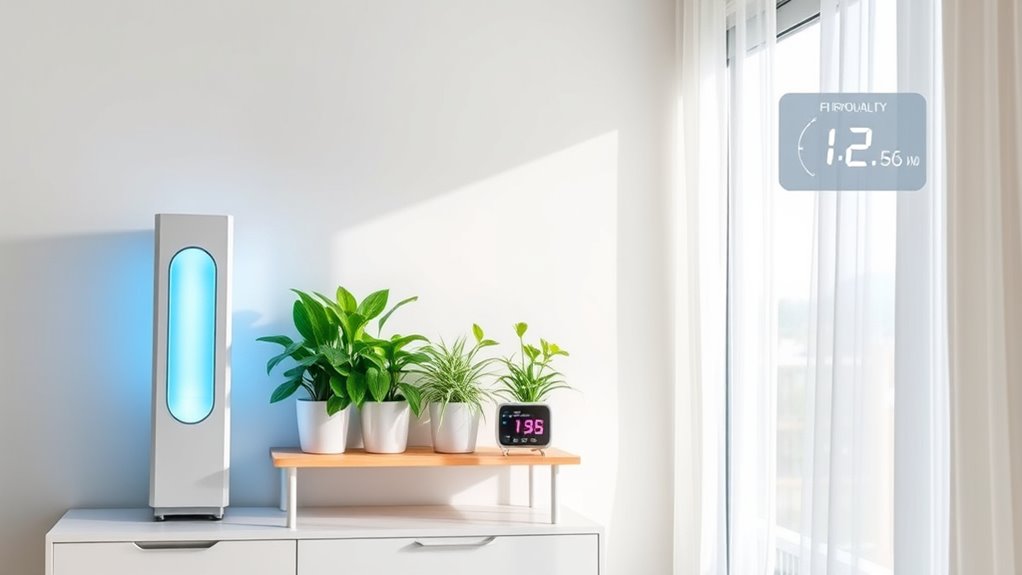To guarantee good indoor air quality, identify common pollutants like dust, mold, and allergens, and manage their sources. Maintain proper ventilation and air circulation using natural methods or filters, and keep humidity between 30-50% to prevent mold growth. Choose effective air purifiers with HEPA and activated carbon filters, and regularly replace them. Additionally, control moisture levels, limit indoor pollutants, and keep your space clean. If you keep exploring, you’ll discover even more ways to improve your indoor environment.
Key Takeaways
- Understand the importance of indoor air quality and its impact on health and well-being.
- Identify common indoor pollutants like radon, allergens, and chemicals, and implement source control measures.
- Maintain proper ventilation, humidity control, and mold prevention techniques to ensure a healthy environment.
- Use effective air purification devices, regularly replace filters, and reduce pollution sources indoors.
- Stay informed about emerging technologies, resources, and best practices to continuously improve indoor air quality.
Understanding Indoor Air Quality and Its Impact
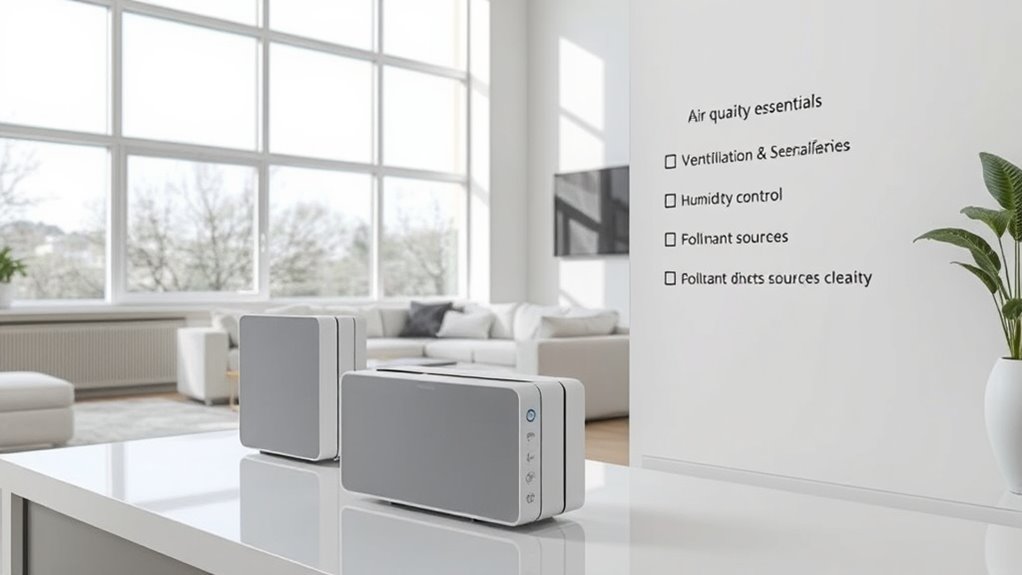
Understanding indoor air quality is vital because the air you breathe inside your home or workplace directly affects your health and well-being. Poor air quality can lead to a variety of health effects, from minor irritations to serious respiratory issues. That’s why establishing air quality standards is essential—they set safe pollutant levels to protect you. When indoor air exceeds these standards, you’re more likely to experience symptoms like headaches, allergies, or asthma flare-ups. Recognizing how indoor air quality impacts your health helps you take proactive steps to create a healthier environment. Regularly monitoring indoor air quality ensures you stay within safe limits, reducing the risk of long-term health problems caused by pollutants or poor ventilation. Air purification technology plays a crucial role in maintaining healthy indoor environments. Your environment directly influences your overall health and comfort.
Identifying Common Indoor Pollutants

Many common indoor pollutants originate from everyday activities and household items, making it important to recognize what might be contaminating the air you breathe. Radon detection is essential because this odorless gas can seep into your home from the ground, increasing health risks over time. Testing for radon helps you identify its presence and take necessary measures. Additionally, allergen sources like pet dander, dust mites, mold, and pollen are frequent indoor pollutants. These allergens can trigger asthma and allergy symptoms, especially if you’re unaware of their presence. Keeping an eye on these common pollutant sources allows you to take targeted steps to reduce exposure. Understanding indoor air quality and its impact on health can help you create a healthier living environment for you and your family.
Ensuring Proper Ventilation and Air Circulation

Proper ventilation and air circulation are key to maintaining good indoor air quality. You can choose from different system types and use strategies like fans or open windows to improve airflow. Natural ventilation offers simple, cost-effective benefits that help keep your indoor environment fresh. Incorporating air quality monitoring devices can also help you track and maintain optimal indoor conditions.
Ventilation System Types
Choosing the right type of ventilation system is essential to guarantee effective air circulation and maintain indoor air quality. You should consider systems that incorporate filtration systems to trap airborne pollutants and improve air purity. Proper duct design is equally important, ensuring that airflow is balanced, efficient, and reaches all areas of your space. For example, forced-air systems use ducts to distribute filtered air, while exhaust fans remove stale air from specific zones. Centralized HVAC units can provide consistent ventilation, but they require careful planning of duct layout. Properly designed systems help prevent air stagnation and reduce indoor pollutants. Additionally, understanding industry transformations such as AI automation can guide you toward more innovative ventilation solutions. By selecting the right ventilation type with effective filtration and duct design, you create a healthier indoor environment and promote good air quality throughout your space.
Air Circulation Strategies
Effective air circulation relies on implementing strategies that promote consistent movement of air throughout your space. You can optimize airflow patterns by positioning fans and vents to encourage even circulation, preventing stagnation. Circulation techniques such as oscillating fans or strategically placed air purifiers help distribute air more effectively, reducing pollutants and humidity pockets. Ensure vents are unobstructed and consider using ceiling fans to complement your existing ventilation system. By managing airflow direction and speed, you create a balanced environment that maintains fresh air and minimizes indoor pollutants. Proper circulation not only improves air quality but also enhances comfort. Regularly assess how air moves in your space and adjust circulation techniques as needed to maintain optimal indoor air quality. Additionally, understanding the importance of air circulation strategies can help you tailor your approach for maximum effectiveness.
Natural Ventilation Benefits
Natural ventilation offers a simple and energy-efficient way to improve indoor air quality by allowing fresh air to flow freely through open windows, doors, and vents. This organic airflow promotes outdoor air exchange, reducing indoor pollutants and stale odors. By harnessing outdoor air, you can lower the buildup of indoor allergens, mold, and chemicals, creating a healthier environment. Proper natural ventilation also helps regulate indoor humidity levels, preventing excess moisture that can lead to mold growth. When you prioritize natural airflow, you’re harnessing a passive method that minimizes reliance on mechanical systems, saving energy and reducing costs. Additionally, incorporating glycolic acid in skincare routines can enhance skin texture and clarity, complementing overall health and well-being. Overall, embracing natural ventilation benefits both your health and your energy efficiency, making it a key component of a all-encompassing indoor air quality strategy.
Managing Humidity Levels and Preventing Mold
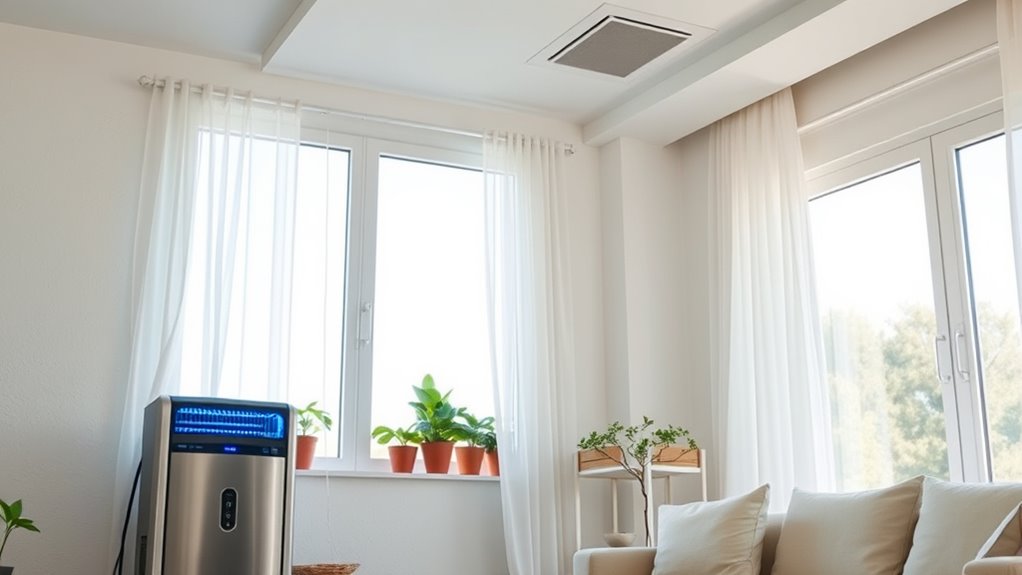
Keeping humidity levels in check helps prevent mold growth and improves indoor air quality. You should use dehumidifiers and fix leaks to control excess moisture effectively. Implementing mold prevention strategies now keeps your home safer and healthier. Incorporating air quality improvements like ventilation and filtering can further reduce mold spores and airborne pollutants.
Controlling Excess Moisture
Controlling excess moisture in your home is essential to maintaining good indoor air quality, as high humidity levels can lead to mold growth and other health issues. To manage this, you should:
- Use effective dehumidification techniques, such as portable dehumidifiers or HVAC systems with dehumidify settings, to keep humidity below 60%.
- Incorporate mold resistant materials in areas prone to moisture, like bathrooms and basements, to reduce mold development.
- Ensure proper ventilation by using exhaust fans in kitchens and bathrooms, and opening windows when weather permits.
These strategies help maintain ideal moisture levels, prevent mold growth, and support healthier indoor air. Regular monitoring and maintenance of your moisture control systems are key to long-term indoor air quality.
Mold Prevention Strategies
Maintaining proper humidity levels is key to preventing mold growth in your home. Aim for humidity between 30-50%, using a hygrometer to monitor levels regularly. Moisture control techniques like fixing leaks promptly and ensuring proper ventilation help keep moisture in check. Consider using mold resistant materials, such as mold-resistant drywall or paint, in areas prone to dampness like bathrooms and basements. Keep surfaces dry and clean, especially in hidden spots where mold can develop unseen. To further prevent mold, use exhaust fans during showers and avoid overwatering plants indoors. These strategies reduce excess moisture, making your home less inviting for mold spores and improving indoor air quality. Staying proactive with moisture management is essential for a healthy, mold-free environment. Incorporating proper moisture control techniques can significantly reduce the risk of mold growth and enhance overall indoor air quality.
Selecting and Maintaining Air Purification Devices
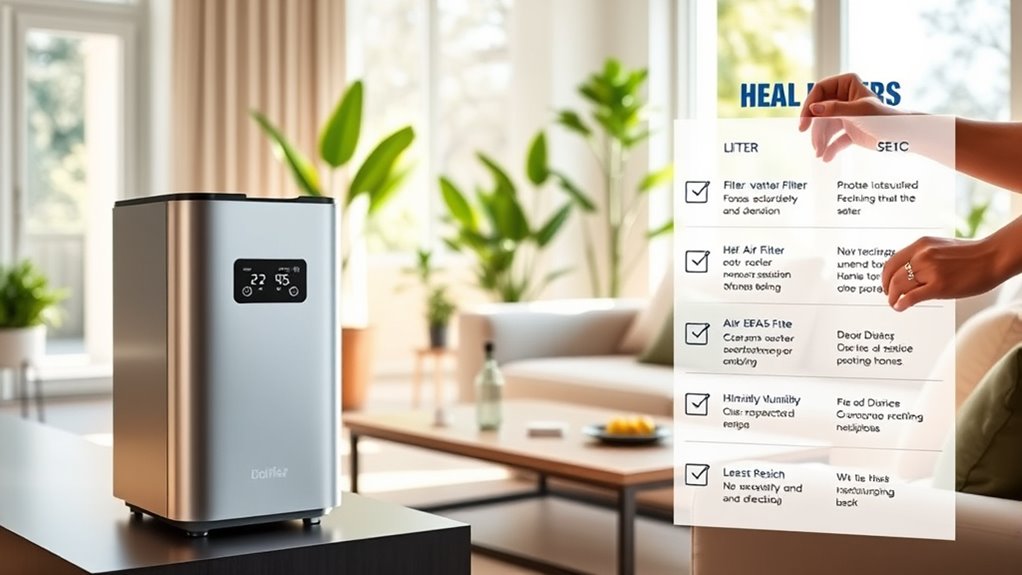
Choosing the right air purification device is essential for improving indoor air quality, especially if you or your family members have allergies or respiratory issues. Start by evaluating air purifier ratings to guarantee it effectively removes pollutants. Look for models with high CADR (Clean Air Delivery Rate) for better performance. Consider HEPA filters, which capture 99.97% of airborne particles, including allergens and dust. When maintaining your device, keep these steps in mind:
Choosing the right air purifier improves air quality and reduces allergens effectively.
- Regularly replace HEPA filters according to manufacturer recommendations.
- Clean pre-filters monthly to prevent clogging and maintain efficiency.
- Check and replace activated carbon filters for odor and chemical removal.
- Understand filter types to select the most suitable options for your needs.
Proper selection and upkeep maximize your device’s lifespan and secure optimal indoor air quality.
Reducing Indoor Sources of Pollution
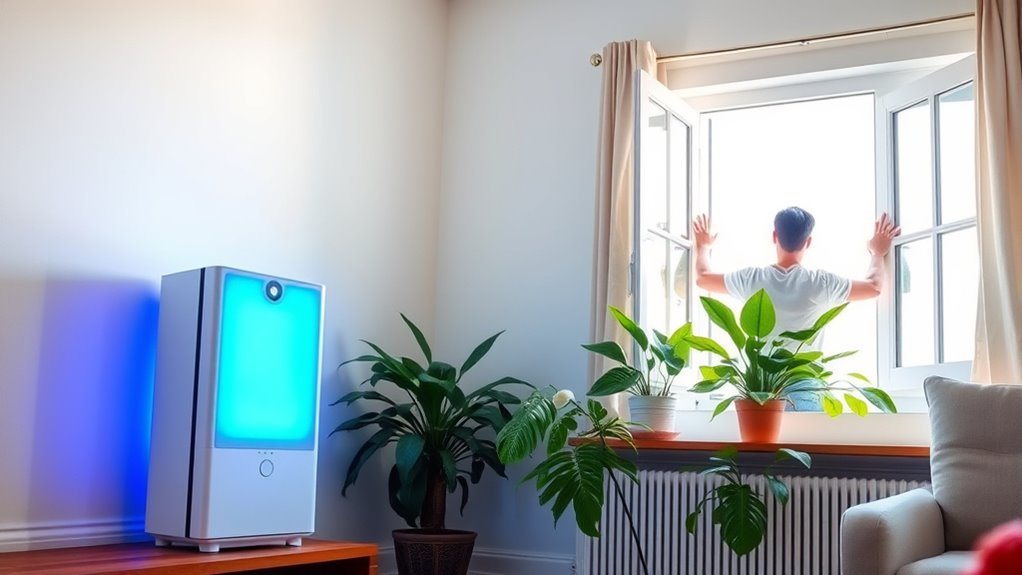
Reducing indoor sources of pollution is a essential step in improving your home’s air quality. Start by choosing the right air purifier selection to target common pollutants like dust, pet dander, and allergens. Make sure to select a device with a HEPA filter for effective removal. Controlling humidity levels also plays a key role; aim to keep indoor humidity between 30-50%. Proper humidity control prevents mold growth and reduces dust mites, both of which contribute to poor air quality. Avoid smoking indoors, limit the use of harsh cleaning chemicals, and store volatile substances securely. Ventilate your home regularly to allow fresh air in and stale air out. These steps will notably reduce indoor pollution sources and create a healthier environment. Additionally, staying informed about AI discoveries can help you understand emerging technologies that could further improve indoor air quality and health.
Regular Cleaning and Maintenance Practices
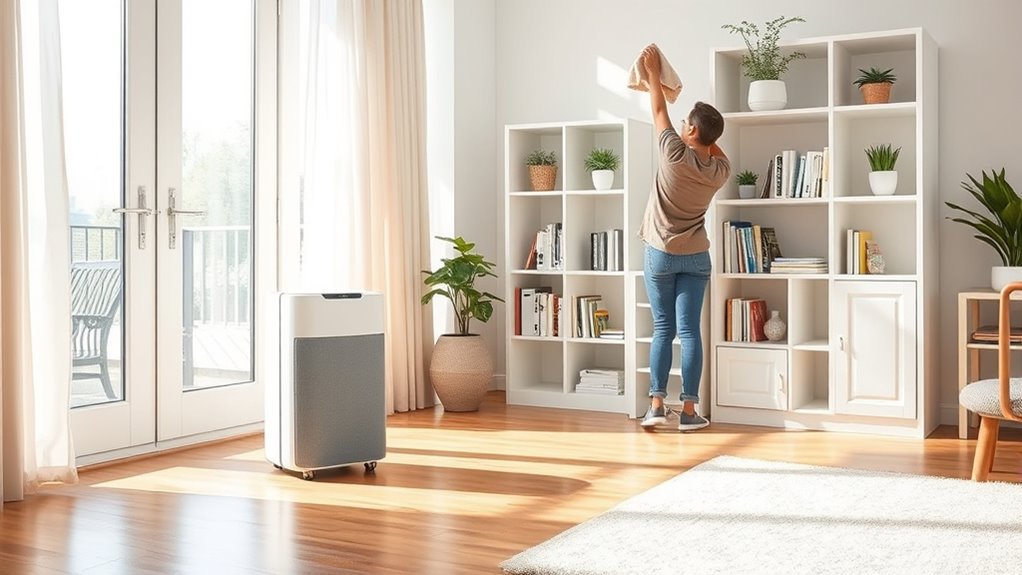
Regular cleaning and maintenance are essential for sustaining good indoor air quality. To keep your environment healthy, follow a consistent cleaning schedule. First, check and replace air filters regularly—ideally every 1 to 3 months—to reduce dust, allergens, and pollutants. Second, establish a cleaning routine that includes dusting, vacuuming with a HEPA filter, and wiping down surfaces weekly. Third, ensure ventilation systems are maintained, including duct cleaning when needed. Proper air filter replacement prevents buildup of contaminants, while sticking to cleaning schedules minimizes dust and mold growth. Additionally, verifying that your HVAC system and air filtration methods are compliant with safety standards reduces the risk of scams, ensuring you make informed decisions. These practices not only improve air quality but also extend the lifespan of your HVAC system. Staying diligent with regular maintenance is key to a healthier, fresher indoor space.
Frequently Asked Questions
How Do Indoor Plants Improve Air Quality?
Indoor plants, especially air purifying plants, improve air quality by filtering toxins and increasing oxygen levels. You can enhance their benefits with proper plant care tips like regular watering, adequate sunlight, and proper humidity. These plants absorb pollutants like formaldehyde and benzene, making your environment healthier. Including air purifying plants in your space is a natural way to boost air quality, and following plant care tips guarantees they stay healthy and effective.
Can Pets Significantly Affect Indoor Air Pollution?
Pets can definitely stir the pot when it comes to indoor air pollution. Their pet dander and odors can hang around, making it harder to breathe clean air. You might think it’s no big deal, but it’s like opening Pandora’s box—these allergens and smells can accumulate quickly. Regular cleaning, good ventilation, and air purifiers help control pet odor and dander, keeping your indoor air fresh and healthier.
What Are the Signs of Poor Indoor Air Quality?
You might notice symptoms like frequent headaches, allergies, or respiratory issues, which can indicate poor indoor air quality. Keep an eye on air quality sensors that detect pollutants, humidity levels, and airborne particles. If your ventilation systems aren’t working well or are poorly maintained, stale air and odors can linger, making your space uncomfortable. Addressing these signs promptly helps improve air quality and creates a healthier environment for everyone.
How Often Should Air Filters Be Replaced?
You should replace your air filters every 1 to 3 months, depending on the filter lifespan and your home’s conditions. Check your filters regularly, especially if you notice dust buildup or reduced airflow. Following a consistent replacement schedule helps maintain indoor air quality, prevents allergens from circulating, and guarantees your HVAC system runs efficiently. If you have pets or allergies, consider replacing filters more frequently for ideal air cleanliness.
Are There Natural Methods to Purify Indoor Air?
Ever wondered if natural remedies can improve your indoor air quality? You can boost air purification naturally by using houseplants, which absorb toxins and increase oxygen. Ventilate your space regularly to let fresh air circulate, and use essential oils like eucalyptus or tea tree for their air-cleaning properties. These simple, natural methods help reduce pollutants, creating a healthier home environment without relying solely on mechanical air purification.
Conclusion
By paying attention to indoor air quality, you’ll notice how fresh, clean air becomes a natural part of your daily life—almost by coincidence. When you regularly check pollutants, optimize ventilation, and keep your home well-maintained, better air quality seems to happen effortlessly. In the end, creating a healthier indoor environment isn’t just about routines; it’s about making small, intentional choices that align perfectly with your well-being, often when you least expect it.
